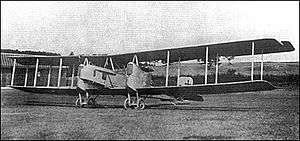Gotha G.III
| Gotha G.III | |
|---|---|
 | |
| Role | Bomber |
| Manufacturer | Gothaer Waggonfabrik AG |
| Designer | Hans Burkhard |
| First flight | 1916 |
| Primary user | Luftstreitkräfte |
| Produced | 1916 |
| Number built | 25 |
|
| |
The Gotha G.III was a heavy bomber used by the Luftstreitkräfte (Imperial German Air Service) during World War I. It succeeded the G.II in production and differed primarily in the choice of powerplant. The eight-cylinder Mercedes D.IV, which had proven highly susceptible to crankshaft failure, was replaced by the new six-cylinder 190 kW (260 hp) Mercedes D.IVa engine. The G.III also had a strengthened fuselage with an extra 7.92 mm (.312 in) machine gun firing through a ventral trapdoor. The G.III was also the first bomber to have a tail gun with a potential 360 degree arc of fire.[1]
Operational history
Most of the 25 G.III aircraft produced were delivered to Kagohl 1, operating in the Balkans out of Hudova — such units with the "OHL" concluding letters were under direct control of the Oberste Heeresleitung high command of the German Army. Combat service of the G.III was limited but effective. Its most notable accomplishment came in September 1916, when a formation of G.III aircraft destroyed the railway bridge over the Danube River at Cernavodă, Romania. It also saw use by Kagohl 2 on the Western Front, operating from Freiburg. Following the delivery of the G.IIIs to this unit, its commander complained to Berlin about the performance of the aircraft, not because they were too slow, but because they were outrunning their escort fighters. In September 1917, all surviving aircraft were withdrawn from combat and relegated to training units.
Operators
Specifications
General characteristics
- Crew: Three
- Length: 12.2 m (40 ft 0 in)
- Wingspan: 23.7 m (77 ft 9 in)
- Height: 3.9 m (12 ft 10 in)
- Wing area: 89.5 m2 (563 ft2)
- Empty weight: 2,383 kg (5,253 lb)
- Gross weight: 3,618 kg (7,976 lb)
- Powerplant: 2 × Mercedes D.IVa, 193 kW (260 hp) each
Performance
- Maximum speed: 135 km/h (83 mph)
- Endurance: 3 hours 45 min
Armament
- 2 to 3 × 7.92 mm (.312 in) Parabellum MG14 machine guns
- 500 kg (1,100 lb) of bombs
See also
- Related development
- Aircraft of comparable role, configuration and era
- Related lists
Notes
- ↑ Murphy, Justin: Military Aircraft, Origins to 1918: An Illustrated History of Their Impact. Published by ABC-CLIO, 2005. Page 175. ISBN 1-85109-488-1
References
| Wikimedia Commons has media related to Gotha G.III. |
- Taylor, Michael J. H. (1989). Jane's Encyclopedia of Aviation. London: Studio Editions. p. 426.
- World Aircraft Information Files. London: Bright Star Publishing. pp. File 895 Sheet 08.
- Grosz, Peter M. (1966). The Gotha GI - GV. Leatherhead, Surrey: Profile Publications.
- Grosz, Peter M. (1994). Gotha!. Berkhamstead, Hertfordshire: Albatros Productions.